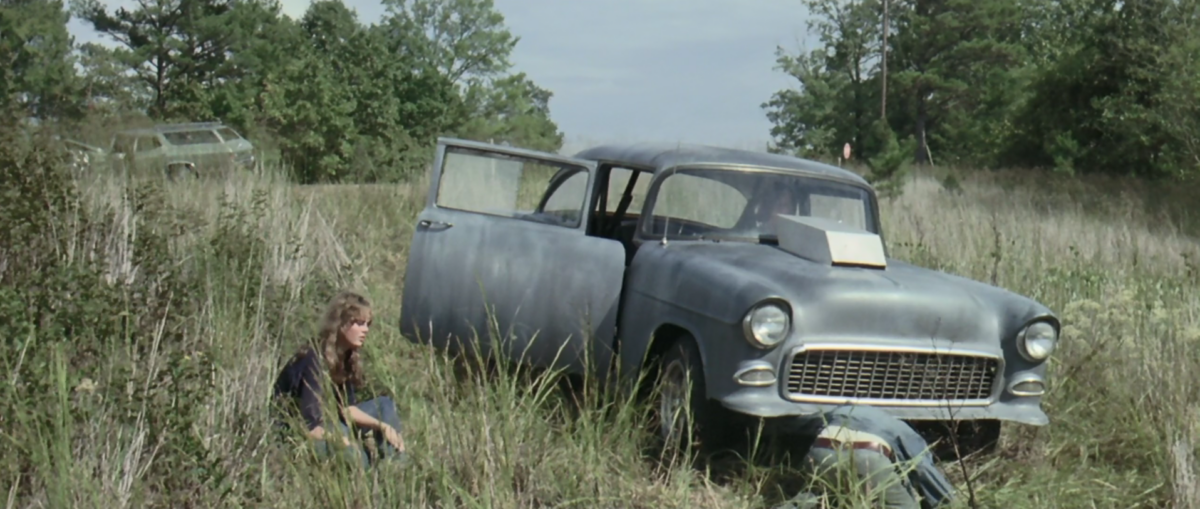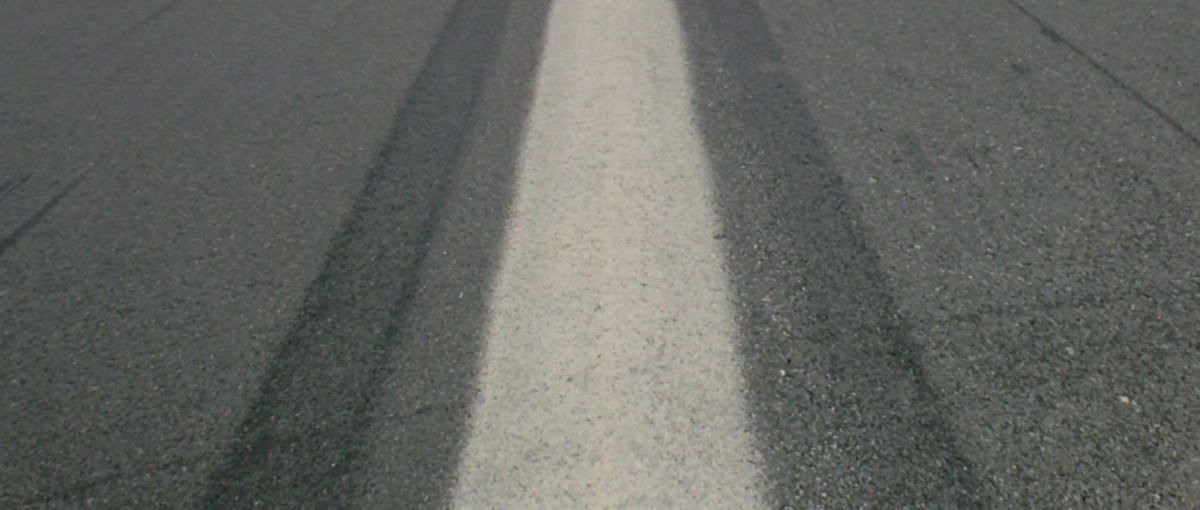If all the young people in the world start doing nothing… the world is in danger. So much the better. So much the better.
The close bond between modern cinema and the automobile is a well-established fact. Automobility has greatly influenced its cinematic gaze and the visual and narrative strategies it employed. The road movie genre from the 1940s to 1970s can be seen as an extension of the Western with which it shares its “romantic drive into wide open spaces and, at the same time, into the innermost recesses of the displaced subject”.Laderman, David. Driving Visions: Exploring the Road Movie. University of Texas Press, 2010. On the other hand, it reflects the profound cultural shifts that shaped the American continent after the Great Depression and World War II, establishing a more fluid relationship to time, space and identity. People go on the road to alter their perspective and distance themselves from their everyday lives. Being on the road means to be away from (the idea of) home, ready for encountering other ways of living. Rebellion against conservative social norms is also a typical road-movie trope. Its ma(i)nly male protagonists usually undergo a certain identity crisis in which American car culture becomes a vehicle for self-discovery. They experience a rather vague quest from freedom which oscillates between what Manohla Dargis calls “the pleasure principle on wheels” (as epitomised by beat hero Dean Moriarty in Kerouac’s On the Road) and “the death drive on wheels” (as epitomised by James Dean who died in an illegal car race in 1955). Both antipodes are interconnected, and together they embody the modern form of masculinity which is “founded on speed and fragmentary, fleeting images produced by the ‘visual apparatus’ of man, car and windshield.” One cannot ignore the consumerist drive promoted in the classic road movies, which tends to associate American car culture and American youth culture. The oil and auto industries did their best to sell their product as a mass medium. As a result, the movies’ audience equate freedom and independence with consumerist behaviour and often blatant chauvinism. Mark Williams formulates this hedonistic credo in The Complete Guide to Cinema on Wheels: “Get in this large, sexy car, drive fast; seduce women, gain freedom; be a hero whatever the odds.”
As far back as 1923, D.H. Lawrence denounced the ostensible free spirit of the American drifter: “Men are less free than they imagine; ah, far less free. The freest are perhaps less free… Men are free when they belong to a living, organic, believing community… not when they are escaping to some wild west. The most unfree souls go west, and shout of freedom. Men are freest when they are most unconscious of freedom. The shout is a rattling of chains, always was.” Monte Hellman’s existentialist, nihilistic road movie Two-Lane Blacktop (1971) focuses on young drifters and exposes romantic fantasies of life on the road to the cold light of reality. It would be the last film he would make inside the Hollywood system—it crashed and burned at the box office. The legendary producer Roger Corman famously said it was the only film he ever lost money on. It is perhaps not surprising that the audience of the time didn’t respond to its bleak and despairing view of the human condition. It has all the main components of Hellman’s cinema—characters aimlessly drifting on the margins of society inside a correspondingly peripatetic cinematic structure. Hellman shifts focus from the landscape to the film experience itself, marking the futile passing of time in a gruelling, torturous way. The road does not provide liberation; it brings entrapment and exposes the difficulty men have relating to each other without an external reference point—in this particular case, cars.
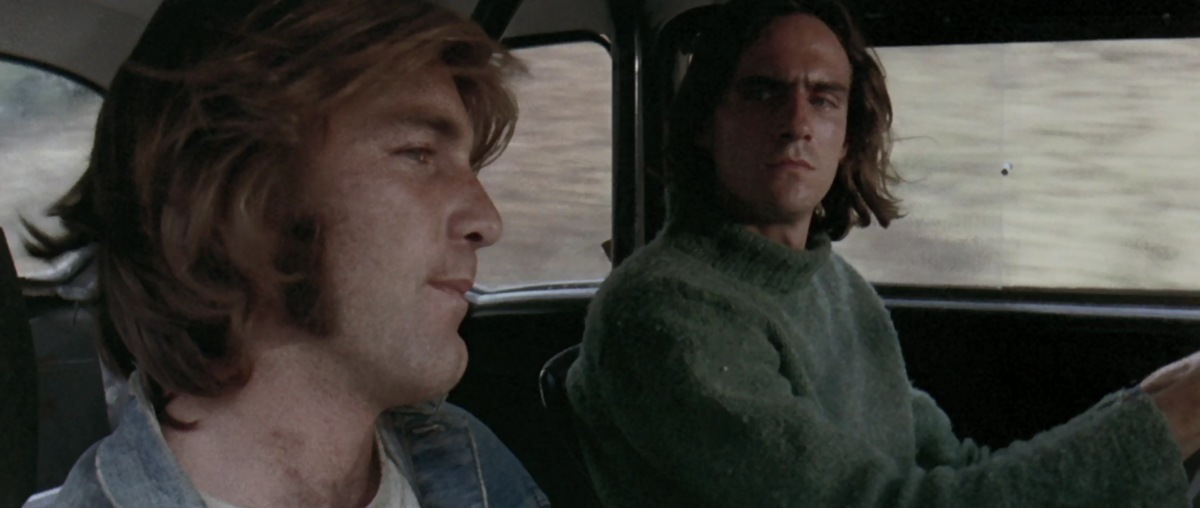
The Driver (singer-songwriter James Taylor) and the Mechanic (Beach Boys drummer Dennis Wilson) drift aimlessly from town to town in their Chevy 150, challenging local residents to impromptu drag races. Their paths cross with an attractive hitchhiker (Laurie Bird) and the older but inexperienced, talltale-spinning driver of a GTO (Warren Oates). Their lives seem to be completely subjugated to the capers of fate, and no evident pattern—benevolent or malevolent—can be detected in their actions. We know nothing of their past lives, worldviews or destinations and we struggle to detect comprehensive personalities behind their vacant stares and monosyllabic exchanges. They roam through the American Southwest in a Beckettian trance convincing themselves that they have rejected all societal norms and bourgeois values. Yet they are unable to escape self-made traps: instead of living in the moment they indulge in trivial obsessions, random contests and macho games. As Brad Stevens so poignantly describes in his biography Monte Hellman: His Life and Films (2003), “while most Western protagonists are aggressively goal-centred, Hellman deals with individuals who are either incapable of formulating worthwhile projects, or obsessed with activities explicitly depicted as meaningless.”
Stevens also perceives that in Hellman’s films men are consistently challenged by intelligent and independent women. These women occupy seemingly marginal narrative positions, but their marginality only reinforces the critique he wishes to make of a society dominated, and arranged in accordance with, masculine interests. These closed circles (like the car racing meetups in Two-Lane Blacktop) are perfect and deadly—but these male constructs often “come close to being broken by an intrusive feminine force.” Hence the introduction of Laurie Bird, who sneaks into their Chevy at a diner without asking for permission. She rides in the backseat; the small-town car freaks take no notice of her questions and won’t let her listen to the radio. “Is this some kind of masculine power trip?” she rightly asks. The Driver ignores her at first but soon becomes infatuated and possessively seeks her company. She almost switches cars but refuses GTO’s advances: “Not right now.” Later, she accepts his offer, but then realises he is more of the same. GTO first says they will have a good time in New York and then breaks down and says they will build a house together—he stills dreams of a home and traditional values—“If I’m not grounded soon, I’m going to end up in orbit,” he says. His escape is a ruse. The men all project their fantasies onto her as if trying to find redemption in her embrace. She flirts, yet refuses to be reduced to their romantic interest. Hellman met Bird in New York, and she immediately seemed like a prototype for the kind of character he had in mind. She had no acting experience and was drifting from modelling through film to photography. There is a fragility in Laurie, a darkness and hidden depth behind her happy-go-lucky visage. It is difficult to distinguish where the character ends and the actress begins. Laurie would die a few years later at the tender age of 25—overdosing on Valium (her mother committed suicide when she was the same age).
Instead of monumental landscapes and picaresque adventures in the great American outdoors, their journey takes place in a topography which exists primarily to provide corporations with a means of increasing their profit: during the journey we follow a trail of joyless roadhouses, dreary diners, imposing advertisements and gas stations showcasing signs that forbid dancing or warn drivers not to pick up hitchhikers. In many ways they embody “non-places,” as French anthropologist Marc Auge would later call spaces of transience and anonymity where no spontaneous or genuine human interaction is welcomed (i.e. motorways, airports, shopping malls). Hellman’s camera is deliberately flat and sustained while filming the races—it is completely devoid of an adrenaline rush and makes no attempt to excite the viewer as the opponents cross the finishing line. Instead we see them as the director himself does—as meaningless contests, displays of testosterone and a sheer waste of gasoline. The cars are like frail cages protecting their passengers from the unfriendly exterior, although on occasion a collision is unavoidable. This is especially evident in the shot at the beginning of the final sequence: the camera focuses on the white line in the middle of the road and follows it until it becomes indistinguishable. As Stevens writes, “The road—along with its promise of escape from responsibility and domesticity—implies not freedom, but rather a nightmare that will never end.”
As Hellman himself said, when comparing his film to the much more successful Easy Rider—it is not political so much as sociological and philosophical. The characters don’t use drugs, aren’t violent or blown away in the end. “They are not making a statement; they’re just not interested.” This refusal to participate is exactly what makes the film so subversive. These ghostly youngsters are not anti-heroes—they don’t blow up a lavish desert home (Zabriskie Point) or engage in open gun fire with rednecks (Easy Rider)—their violence is inwardly oriented. By participating in the race, the Driver and the Mechanic are trying to conquer time—to fill it out with mundane rituals and futile tasks and thus hide its relentless passage. Mortality looms over, rendering all their actions ultimately meaningless—this becomes especially clear in the quick procession of final scenes: the Driver, the Mechanic and the Girl uncover the aftermath of a fatal car crash in the middle of the road; GTO picks up a hitchhiker who insists on the triviality of all aspirations, and opts to get out of the car (“It doesn’t matter, what do we have—30 to 40 years?!”), refusing to listen to his tall tales; immediately after he picks up an old woman and her granddaughter who are going to a graveyard to visit the girl’s parents who were recently killed by a city car. The Girl soon realises that they are on a race towards self-destruction—“the death drive on wheels” prevails, but there will not be a violent crescendo, just a slow withering through lacunary spaces they occupy—self-effacement in speed instead of self-annihilation in bloody demolition. They are creating a void, a zero point, a gap between hope and despair.
On the other hand, GTO’s verbal yarn—he has a new story for each hitchhiker he picks up, in the end he even reappropriates the Driver and the Mechanic’s story as his own—compensates for an absence of personality. He believes himself to be a modern cowboy, a “free spirit roaming the asphalt range,” but is in fact “an exemplary product of corporate America,” having bought into the claims of Madison Avenue advertisements and sales brochures, with their emphasis on “performance and image” for a model on which he can construct a satisfying way of life. As Stevens writes, “If the driver conforms to an ideal derived from Easy Rider and On the Road, GTO subscribes to a somewhat older but nevertheless complimentary fantasy, one absorbed from James Bond films and Playboy magazine.” Hellman and Warren Oates expose the desperation and emptiness lurking behind this façade. The Driver, the Mechanic and GTO form an uneasy alliance, unable to break their bond—they are chained to one another in their joyless competition, which they need to see through in order to have something to grasp onto while drifting along. Unable to live in the moment, they anchor themselves by focusing on the task at hand, as well as the ultimate prize of winning over the Girl. Despite initial tension, the three men make a truce—they find solidarity in their quiet despair (“we are in this together”), yet are unable to truly connect. When GTO tries to open up and share his past troubles (or is he just telling another tall tale?) to the Driver—the two men share a fleeting moment of warmth—he soon withdraws and says he doesn’t want to hear it (“it’s not my problem”).
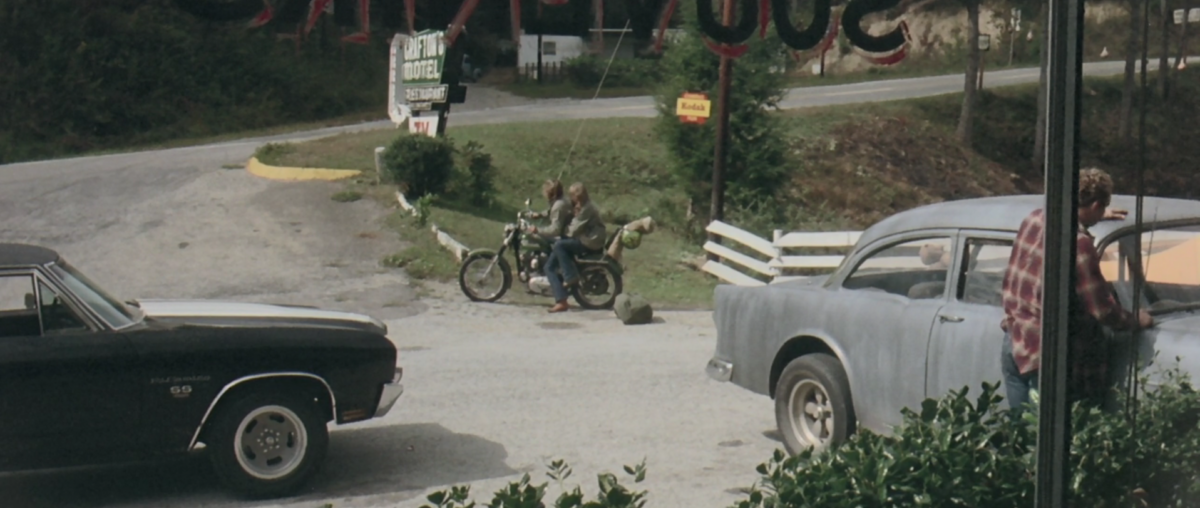
Although part of the same counter-cultural movement as Easy Rider, Hellman’s film is directly opposed to everything that film stood for. Easy Rider is part of a well-established tradition in American literature and cinema—the flight from civilization of two male wanderers, one hip and the other square. Easy Rider’s hippies are peace-loving while the “straights” are caricatured sadists; the distinction between good and evil is crude and one-dimensional. Easy Rider also shows that the counter-culture perpetuated the same notions of masculinity that had always been current in American culture and glorified in American film. There are no female characters in Easy Rider whatsoever, apart from two sex workers who only serve to prove the male protagonists’ virility and allow them to ventilate their suppressed emotions, rather than as flesh-and-blood characters in their own right. On the other hand, Hellman’s road movie takes a decidedly feminist stance. Laurie Bird’s character may on the surface seem like a promiscuous airhead, but she is in fact the true libertine; she seizes the moment whatever it brings, expresses sincere emotions (of fear at seeing a corpse or delight at managing to start the car) and rejects the heteronormative relationship (longed for by both the Driver and GTO) based on possession and sexual exclusivity. Although his male characters think they have renounced the bourgeois life typical for American suburbia, they still cannot entirely escape its value system, forever inhabiting its mental landscapes. Hellman makes the Girl the only genuine rebel of the story—despite being involved with all three men she ultimately rejects them. Her final words, “No good,“ express a radical protest against the demands they try to impose on her. Instead of being part of their death race, she takes a ride with a motorcyclist she meets at a diner, exiting their lives the same way she entered them, in a carefree, “anything goes” manner. Her luggage is too heavy for the bike, so she must leave it on the ground. The determination with which she abandons her last possessions is profoundly moving. In this remarkable and fearless gesture she is more in control of her fate than the three men will ever be.
The fellows divide their time into repetitive patterns—throughout the film they fill it up with mundane tasks and empty rituals—obsessing over their carburettor’s efficiency and other mechanical features. The Girl repeatedly asks if she can hear music on the radio, but the Driver dryly responds “It gets in the way.” He only offers to change things up and embrace spontaneity once he suspects he might lose her, promising to take her to Florida and “find some nice beaches”. Rather than savouring time’s passage like the Girl they choose to speed it up, as if they are afraid of being idle. Perhaps they fear it will lead to mischief, internalising the old proverb: idle hands are the devil’s playground. One can never go fast enough to escape the inner workings of the capitalist system. The film’s epilogue (added to the original script at Hellman’s insistence) sees the Driver and his faithful Mechanic participate in yet another race (one feels there are many more to come). The image slows down, the film catches on fire and burns. Instead of an expected and brutal crash Hellman thus ends his film with a melancholic tone—death would be an easy exit, but the futile race continues while the image collapses under the weight of the pointless narrative. The effect is devastatingly emotional, and one is overwhelmed by a tremendous sense of loss.
This final shot simultaneously reveals and resists the subordination of cinematic time to constraints of narrativity and telling the story within the Hollywood system. It also reminds us of the fragility of film material—almost 80–90 % of films made before the 1930s are lost forever and even in the digital world the question of preservation cannot be separated from dictates of ideological and marketable forces. Hellman finds no better way to escape this contradiction than to destroy the aesthetic illusion that supports and reinforces it. Cinema exposes itself to be a smokescreen, a mere distraction, a dangerous and expensive toy ultimately leading nowhere and burning up in its high ambitions. The film director himself is a charlatan playing a game with no winners. Hellman’s final film (after an almost 20-year long hiatus and 50-year long exile from Hollywood studio filmmaking) is appropriately titled Road to Nowhere (which could be an alternate title for Two-Lane Blacktop as well) and dedicated to his muse Laurie Bird. In it he reveals himself as a player absorbed in his cinematic pursuit, which he deems utterly meaningless in the end.
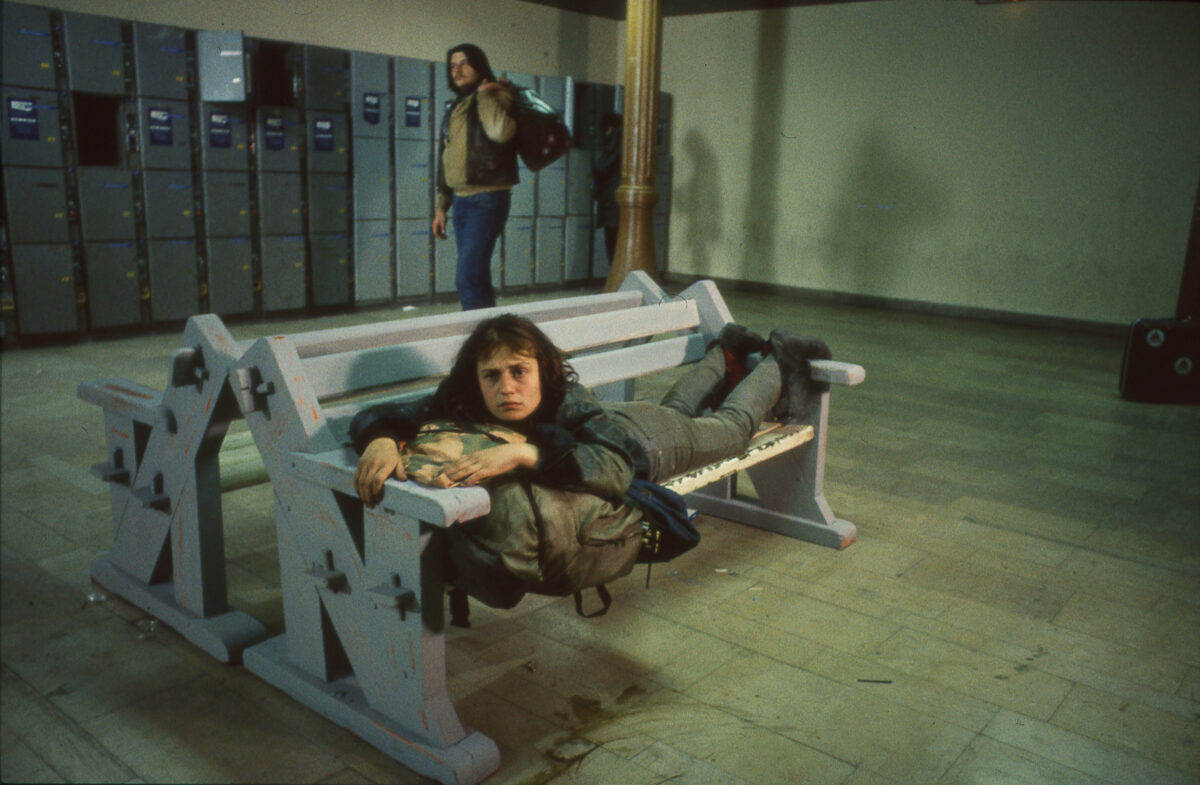
Hellman’s unnamed heroine finds a kindred spirit in another free-wheeling and elusive female hitchhiker—Mona in Sans toit ni loi (1985), Agnès Varda’s most radical film with a unique feminist sensibility. Amid a bare and rigid winter landscape of rural France, we follow the winding path of Mona (Sandrine Bonnaire), a homeless woman with a complex and contradictory character. She survives on scraps and fleeting encounters with strangers. She spends her days walking along the roadside, hiding from the police and trying to hitch a ride. The beginning is the end: the film opens with a scene in which we discover her dead body in a ditch, frozen to death. Then, through a series of analepsis and interviews with people who she encountered during her nomadic existence, a reconstruction of the last days of her life follows. The precariousness of Mona’s existence is far removed from the archetype of the free-spirited and romantic drifter (this type of itinerant seems exclusively reserved for men) and stems from her outsider position as a woman in a patriarchal society. Varda uncompromisingly demonstrates how dangerous and short-lived the undefined space that her anti-heroine occupies is due to her distancing from social expectations related to gender and class.
Mona’s portrait is made almost entirely of what other people say about her. Mona herself barely speaks. Her silence is a form of resistance—she is a destroyer of language, another creator of the void. She wants nothing and gives away nothing and dies without leaving a trace. Mona intrigues, disturbs and disgusts the people she meets. Her dirty, vagabond state embodies a complete rejection of the charms of femininity and social conventions. She is the embodiment of abjection as Julia Kristeva defined it in her seminal work, Powers of Horror. Mona is lazy and disobedient, cunning when she needs to be, ready to do anything just to get through the day with as little effort as possible. Without any apparent agenda or purpose, Mona abandons lovers and friends, connecting with people only to later reject them. The icy skies, the wind blowing the ashen sand and the frozen fields of grain reflect the cold, bleak and callous world whose margins Mona inhabits.
She wanders the Languedoc-Roussillon wine country, where there are a lot of beautiful-but-neglected old villas—during the season there are 90 000 residents and in winter only 3000. This means that there are 87 000 empty beds, but Mona is not offered any of them—if she wants bread and lodging, she needs to become a productive member of the society she rejects. Mona explains to one of her temporary companions that at one time she was a secretary in Paris but became unsatisfied with the way she was living, choosing instead to wander the country, free from any responsibility. Along her journey she takes up with other vagabonds as well as a Tunisian vineyard worker, a family of goat farmers, an agronomy professor, and a maid who envies what she perceives to be Mona’s adventurous and passionate lifestyle. The nearly-abandoned estates Mona visits are marked by the only value our society is willing to defend—the right to property. Everywhere there are signs of inhospitality—“no trespassing” and “beware of dogs”. She is met with distrust because of her gender as well; as one woman puts it, “female drifters are all either loafers or man chasers.” Even fellow outsiders reject her—she gets on well with the Tunisian vineyard worker she meets, but as soon as his migrant roommates return, she is expelled—they don’t want to live with a woman.
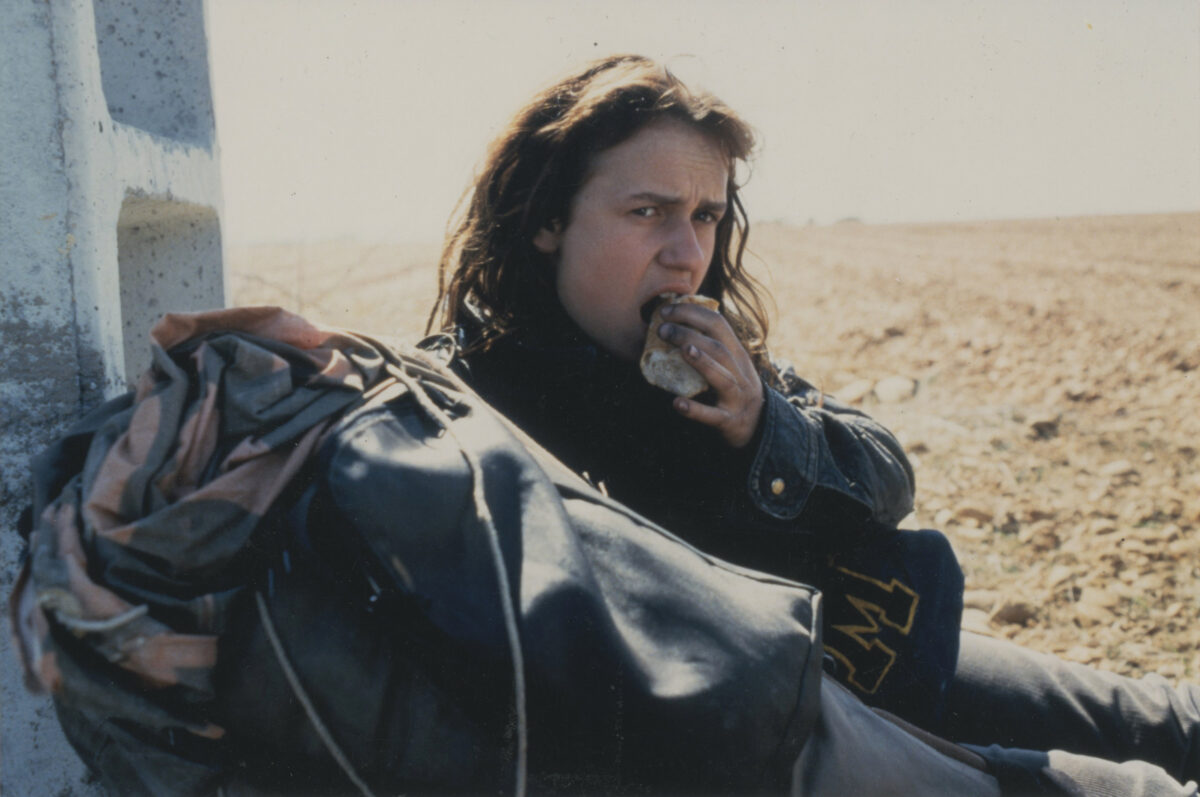
With one of the goat farmers, who is a former philosophy teacher, Mona has one of her most meaningful exchanges—he offers her a piece of land where she can stay and live off what she produces. She stays for a while but cannot adapt to the lifestyle and finds him to be patronising. He calls her lazy, and she responds that he lives in filth just like her—he just works more. He defines his own value through work, but Mona doesn’t feel the need to justify herself—she demands what she feels she is entitled to as a human being. She rejects the very notion that she needs to earn something that should be free for all and reproaches the society that the goat farmer in the end replicates to a certain extent via the harsh work ethic he imposes on himself and his family. Portrayed by the delicate but resilient Sandrine Bonnaire, Mona is an enigmatic figure prepared to defend her right to idleness until her very last breath. At times it is difficult for us to sympathise with her, yet we envy her courage. Varda never questions her decision or judges it—she rather puts the mirror on the society Mona rejects, how perverse this society must be if Mona prefers this harsh life full of peril where she is consistently used and abused. She chose total freedom but got total loneliness—perhaps they are one and the same?
Anthropologist David Graeber shows how our perception of time shifted with the advent of capitalism. It has now become possible to buy one’s time—the worker’s time is not his own, it belongs to the person who bought it, i.e. his employer. Therefore, to be idle is dangerous, it is a subversion, a theft. One should always remember that the Greek word for leisure (scholé) is the origin of Latin scola, English school—the ancients felt that only a mind unhindered by profit, productivity and politics could grasp philosophy. This is so different from our society which only recognizes the false dichotomy between productive work and unproductive amusement. As the goat farmer says about Mona, “She’s not wandering, she is withering. By proving that she is useless, she helps the very system she rejects.”
In places where there are no clocks, time is measured by activity instead of an activity being measured by time. The clock altered human life not only by synchronising it, but also by increasingly dissociating it from the organic patterns of life: time-keeping soon becomes time-serving. Evans-Pritchard writes about the Nuer people from South Sudan who have no concept of time in their language and therefore don’t perceive it as something that lasts, passes, can be lost, saved, bought, etc. They live without being in a race with time or having to coordinate their activities with an abstract flow of time—their points of reference are mostly the activities themselves which are generally of a leisurely nature. Once time becomes money, it becomes possible to spend it and waste it instead of just embracing its passage—it is both a moral and a technological change—time becomes a limited commodity one needs to carefully dispose with—we become slaves to time and the internalisation of this attitude as something “natural” lies behind contemporary work ethics and capitalist surveillance techniques. If idleness is a theft of somebody else’s time, our free time also needs to be productively used for self-improvement and even the pursuit of enjoyment becomes a chore. While Mona and the Girl rebel against this, naively but decisively trying to live only in the moment, the Mechanic, the Driver, and the GTO struggle to truly free themselves of time’s drudgery. Both Mona and the Girl are prepared to sacrifice everything for their freedom, but the question remains whether the true drift is really a choice or a compulsion. They are both compelled to move on and blindly test their luck with strangers, at times blurring the line between being disobedient and refusing to take responsibility for their actions. Blacktop sees the Girl triumphantly exiting the male unit, its toxic rivalry and flirtation with death but she still leaves on the backseat—the steering wheel stays in the biker’s control. Mona is like a wilder, abject version of The Girl. She takes more dangerous risks, does not care about her appearance and is more outspoken about her right to idleness. They are equally spontaneous and express emotions candidly—their childlike quality allowing them to quickly adapt to every situation. Still things end tragically for Mona. The Girl’s future is vaguer, but it is difficult to separate it from Laurie Bird’s real-life suicide—it haunts each viewing and hints at a troubled past lurking behind her vivacious exterior. One cannot help but admire the fatal determination with which they drift and embrace their frail existence. If beauty and leisure are encumbered by time and capital, cinematic time restores dignity to its subjects and temporarily takes us to a world before the tyranny of clocks, offering no solace but gently washing us over with melancholy and allowing us to feel its passage oscillating between hope and despair.
